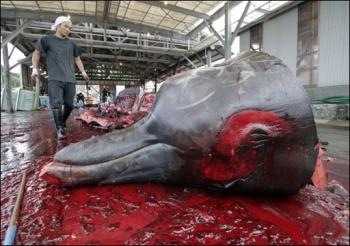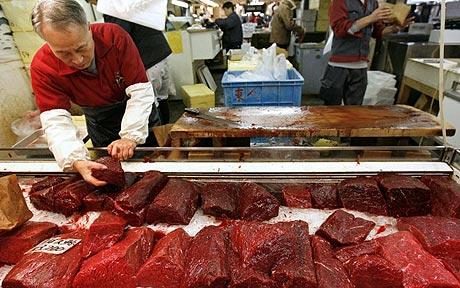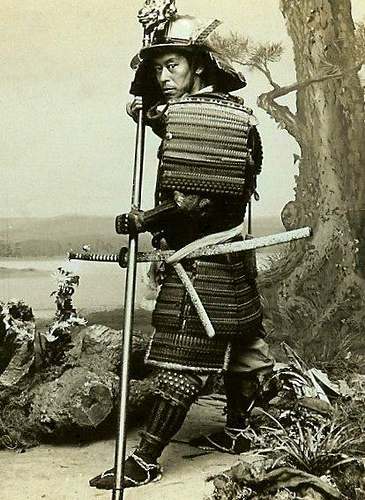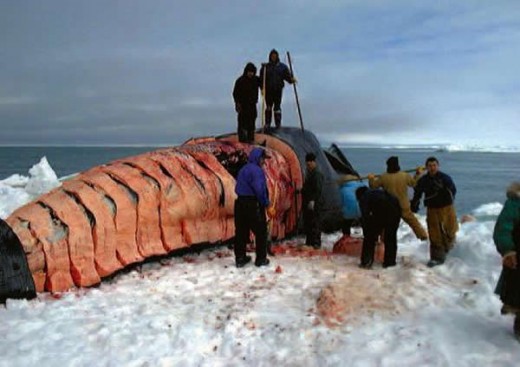Poaching distant whales in foreign oceans
In true Ruddism style (hollow popularism) Australia is domestically making noise while doing squat to resolve Japan’s state-sanctioned slaughter of endangered whale species or to ethically stand up to an illegitimate foreign aggressor. So year on year, the Sea Shepherd Conservation Society does the dirty work of another Australian government.
Japanese whalers are tens of thousands of miles south of Japan in Australian Antarctic waters and seriously outside any feasible extension of what may constitute ‘traditional’ Japanese hunting grounds. They try to argue on the one hand that:
- Whaling is a cultural tradition practiced by the Japanese for centuries and so have an inherent right to continue this tradition, then on the other that
- Japanese whale hunting is purely scientific
.
Combined, the two justifications expose the motive as a prima facie fraud and as one more important that the mainstream media have realised. Japan’s justifications for whaling are not commercial and not scientific. They are culturally deep and desperately self-preserving, despite being wrong, wasteful and backward.
Proud Japan’s once mighty economy overtaking the west through the 1970s and 1980s reached it’s inevitable bubble, but the Japanese rebirth in pride since humilating defeat in World War II, could not foresee a second cultural failure. But when the Japanese real estate and stock price bubble burst in 1990, immediate nation-wide shock and depression ensued lasting throughout the 1990s, which now has been acknowledged as Japan’s Lost Decade.
Worse for Japanese pride has been its once globally accepted and admired business management practices that have consequently fallen into disrepute internationally. These include Japan’s once acclaimed Kaizen management practice, market first product focus, Genbutso Genba (facts, figures and check) learning from competitors, and Hoshin Kanri (process management).
So right now, Japanese pride is at an ebb one could say. Then to hammer the nail into the coffin, Japan has seen its historic arch rival, China, recently replace and exceed Japan’s economic success.
How is Japan’s cultural pride relevant to Japan’s whaling activities in the Southern Ocean?
Well let’s investigate the facts.
Japanese whalers, tens of thousands of miles south of Japan in Australian Antarctic waters and seriously outside any feasible extension of what may constitute ‘traditional’ Japanese hunting grounds, try to argue on the one hand that (1) whaling is a cultural tradition practiced by the Japanese for centuries and so have an inherent right to continue this tradition, then on the other that (2) Japanese whale hunting is purely scientific – is an exposed prima facie fraud.
.
Founder and President of Sea Shepherd Conservation Society, Paul Watson, provides an historical synopsis of the Japanese 19th Century commercial interest in whaling in his article of 27 June 2006 ‘The Truth about “Traditional” Japanese Whaling’:
“In the 1890’s Japanese man, Jura Oka, made his way to Norway, the Azores, and Newfoundland to study whaling and learn of the commercial rewards. Oka then formed the first Japanese whaling company Hogei Gumi with one vessel, the Saikai-maru, and killed a total of three whales. In 1908 the Nihon Hogeigyo Suisan Kumiai was established (Japanese Whaling Association) with Jura Oka as the first President. In 1908 the association’s 12 companies with a total of 28 whaling vessels killed 1,312 whales. The average kill for the next 25 years would be around 1,500 whales.
 ^http://gcaptain.com/australia-sends-armed-merchant-ship-to-track-whalers/?950
^http://gcaptain.com/australia-sends-armed-merchant-ship-to-track-whalers/?950
.
…The 1930’s became the greatest decade of whale slaughter in history. In 1931, 37,438 blue whales were massacred in the Southern Oceans. Japan sent its first ships to Antarctica in 1935. The sale of whale oil helped to finance the invasion of Manchuria and China. In 1937 alone, more than 55,000 whales were slaughtered yielding 3 million tons of animals.”
Post World War II, America’s General Douglas MacArthur, encouraged the revitalisation of a defeated and demoralised Japan.
“In 1946, General Douglas MacArthur proposed the creation of a Japanese whaling fleet to secure protein for the conquered Japanese people. He did so in order to cut down on the United States’ costs of transporting food to post war Japan. On August 6th 1946 MacArthur signed the directive authorizing two factory ships and twelve catcher boats to begin whaling in the Antarctic for the 1946-47 season. The deal was that Japan would get the meat and the oil would be turned over to the United States. The United States provided $800,000 in fuel for the ships and received over 4 million dollars in whale oil in return.
The two ships sent down to Antarctic waters were the Hashidate Maru and the Nishin Maru.” Do these vessel names sound familiar?
.
“The brutal killing of whales has become an icon for the Japanese identity. This is not unusual. Japan has always closely identified with blood and slaughter. From the decapitations by the Samurai upon innocent peasants to the suicidal insanity of the Kamikaze, violence and self destruction have been a part of Japanese culture.”
.
With Japan’s Samurai culture castrated, its military culture castrated, its economic miracle failed, what pride can traditional Japanese otherwise cling to?
Few eat whale meat in Japan. The scientific research of whales is only an excuse so that that Japan can claim to be technically complying with the Antarctic Treaty. But the activity is one of lost Samurais with no other quest. It’s all really quite sad for Japan and symptomatic of a once proud people having become.
.
Japanese arrogance in the Southern Ocean extends to Tokyo
.
On 20 Dec 2009, a US shipwreck search team lead by US marine scientist David Mearns finally found the wreckage of the Australian World War Two hospital ship, the Centaur, which sank in 1943 killing 268 people. Submarine photography has confirmed the gaping hole where the Japanese torpedo and ensuing explosion tore the hospital ship off the Queensland coast just 30 miles east of the southern tip of Moreton Island. The footage shows the ship’s bright red cross and a corroded number 47, its identification number.
At the time supreme Allied commander Douglas MacArthur called the Japanese torpedoing an example of “limitless savagery” and Australian Prime Minister John Curtin said violated “all the principles of common humanity”.
In 1943 the Japanese government issued a statement denying responsibility for the sinking of the Centaur, and has never since acknowledged that Nakagawa was responsible for the sinking. However, an acknowledgment came from the Japanese navy in 1979 in its History of Submarine Warfare, written by Rear Admiral Kaneyoshi Sakamoto. The official history specifically acknowledges that Nakagawa was responsible.
Acting Queensland Premier, Mr Lucas said “In this barbaric act, people lost their lives. Sailors, soldiers, nurses, doctors, orderlies. It was totally senseless and a wanton act” and has called on the Japanese government to apologise to the Australian people. But Japan has refused to apologise.
Australian’s should never forget that Japan is the only nation ever to directly threaten Australia’s sovereignty. Three generations later Japan again defies Australian sovereignty. Some people are a bit slow at getting the message.
Respect for Japan has hit a low. Its government’s disrespectful of the dead, and remains dishonourable over its accountability for its many war crimes such as this.
Survivor Martin Pash, 87, told the Brisbane Courier-Mail that while the Japanese government had issued a general apology for its wartime behaviour, he now sought a direct acknowledgment that the Centaur, which was clearly marked as a hospital ship, should not have been torpedoed. National RSL president Ken Doolan in siding with the Japanese on this issue and stating that the RSL would not be demanding an apology, should hang his head in shame and resign.
.
 Japanese Scientific Whale Meat for sale
^http://www.examiner.com/green-celebrity-in-national/whale-wars-news-sushi-restaurant-serving-whale-meat-southern-california-closes-for-good
Japanese Scientific Whale Meat for sale
^http://www.examiner.com/green-celebrity-in-national/whale-wars-news-sushi-restaurant-serving-whale-meat-southern-california-closes-for-good
.
Tags: Centaur, commercial whaling, Japanese whale poaching, scientific whaling, Sea Shepherd, Southern Ocean, The Antarctic Treaty











